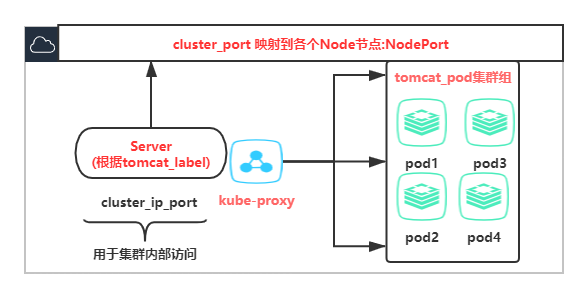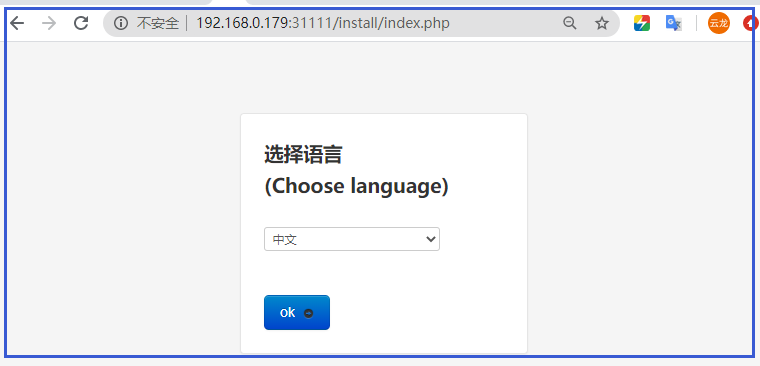k8s uses Nodeport to expose services
There are many ways to expose K8s services. Here we mainly study how to expose services through Nodeport
First of all, we must understand several concepts before exposing ports: *< 1 >. Server: it is a cluster instance entry composed of accessing backend pod replicas. It consists of: ` [cluster_ip] ` virtual ip + '[port]' is composed of. '[cluster_ip] ` because there is no physical network object, this virtual ip cannot be ping ed. *< 2 > '[server]' and '[pod]' replica clusters' are seamlessly connected through the '[label selector]' tag selector. *< 3 > ` [Kube porxy] 'is similar to a software load balancer, which is responsible for forwarding the server's request load to a backend pod instance. *Simple summary: user requests arrive at the server cluster entrance through the Node node (IP+port). The server selects the relevant pod cluster according to the label selector, and then loads the request to a certain pod in the back end through the Kube proxy.
Note: the IP and port of the server cluster portal are mapped to the specified port of each node, so the server portal can be accessed by users from any node. Note: for external access, you only need to access from one node, and other nodes are used as standby.
As shown in the figure below:

Next, create a pod instance
#Toggle namespace kubens showdoc cat >/home/data/k8s/showdoc_project/showdoc.yaml<<"EOF" #Create namespace #apiVersion: v1 #kind: Namespace #metadata: # name: ns-showdoc # labels: # name: ns-showdoc # --- apiVersion: v1 #Version number, query: kubectl API version kind: Service #Created resources can be pod,server, Deployment, etc metadata: #Metadata required namespace: ns-showdoc #Binding namespace name: showdoc-svc #Service resource name spec: #Definition details type: NodePort #type selector: #tag chooser app: container-name-showdoc-pod #The binding reference name is the same as the pod name ports: #Define port - port: 6666 #Port specifies the server port, which is used for internal access of the cluster targetPort: 80 #Bind pod port nodePort: 31111 #Map the server port to the port of Node node for external network access protocol: TCP #Port protocol --- #Deployment is responsible for creating and updating apps. After the deployment is created, Kubernetes master will schedule the application instances created by the deployment to each node in the cluster. #Kubernetes Deployment Controller continuously monitors these instances. If the nodes of the management instance are shut down or deleted, the Deployment Controller will replace them for self-healing apiVersion: apps/v1 #edition kind: Deployment #Specify the created resource role. In the previous version, rc is used. In the new version, rc is replaced by deployment metadata: #metadata namespace: ns-showdoc #Specifies that the namespace defaults to the default space name: showdoc-deployment #Define Deployment resource name spec: #Definition details replicas: 2 #Define default number of copies strategy: #Since replica is 3, the number of pod s in the whole cluster upgrade process is 1-3 direct rollingUpdate: maxSurge: 1 #Rolling upgrade starts a pod first maxUnavailable: 1 #The maximum number of unavailable pod s allowed for rolling upgrade is 1 selector: #Define the tag selector, which should be associated with the app. matchLabels: app: container-name-showdoc-pod template: #Define the replica template for creating a pod metadata: #Define pod template labels: namespace: ns-showdoc app: container-name-showdoc-pod #Specify the name of the pod spec: #Template details containers: #Start defining container - name: container-name-showdoc-pod #Define container name image: star7th/showdoc #Define image imagePullPolicy: IfNotPresent #IfNotPresent: if there is a local image, use the local image instead of pull. If not, pull. Always: always pull, Never; only use the local image, Never pull #command: '[ "/bin/sh","-c","echo 'bestyunyan.com'>/etc/status.log" ]' #Commands executed at startup #args: #- '-web.external-url=$(EXTERNAL_URL)' #- '-alertmanager.url=http://alertmanager:9093/alertmanager' #If command and args are not written, the default configuration of Docker is used. #If the command is written, but args is not, the default configuration of Docker will be ignored and only the command of the. yaml file (without any parameters) will be executed. #If the command is not written but args is written, the command line of ENTRYPOINT configured by default for Docker will be executed, but the calling parameter is args in. yaml. #If both command and args are written, the default configuration of Docker is ignored, and. yaml configuration is used. #Health examination reference of pod: https://blog.csdn.net/weixin_43466473/article/details/103965984 #The health check of pod includes many detection methods such as exec, httpGet and TCP. The results of detection include success, failure and unknown failure #[https://www.cnblogs.com/cocowool/p/kubernetes_container_probe.html](https://www.cnblogs.com/cocowool/p/kubernetes_container_probe.html) #When to use survival probe and when to use ready probe:[ https://www.cnblogs.com/h-gallop/p/11801795.html ] https://www.cnblogs.com/h-gallop/p/11801795.html ) #livenessProbe: #livenessProbe survival probe # httpGet: #There are three detection methods in total: http Get request (more than 200 but less than 400),exec command return value of 0 means OK,tcpsocket monitoring port for detection # path: /install/index.php #Requested interface path # port: 80 #get request port # scheme: HTTP #Detection protocol # initialDelaySeconds: 60 #How long is the delay before checking, in seconds # periodSeconds: 5 #Detect every 5s # timeoutSeconds: 5 #Timeout of probe, default is 1, unit: Second # successThreshold: 1 #How many consecutive detections are successful at least # failureThreshold: 5 #How many consecutive detection failures are considered as failures livenessProbe: #livenessProbe survival probe tcpSocket: #There are three detection methods in total: http Get request (more than 200 but less than 400),exec command return value of 0 means OK,tcpsocket monitoring port for detection port: 80 #get request port initialDelaySeconds: 60 #How long is the delay before checking, in seconds periodSeconds: 5 #Detect every 5s timeoutSeconds: 5 #Timeout of probe, default is 1, unit: Second successThreshold: 1 #How many consecutive detections are successful at least failureThreshold: 5 #How many consecutive detection failures are considered as failures readinessProbe: #readnessProbe ready probe to detect if the container is ready httpGet: #There are three detection methods in total: http Get request (more than 200 but less than 400),exec command return value of 0 means OK,tcpsocket monitoring port for detection path: /install/index.php #Requested interface address port: 80 #get request port scheme: HTTP #Detection protocol initialDelaySeconds: 60 #How long is the delay before checking, in seconds periodSeconds: 5 #Detect every 5s timeoutSeconds: 5 #Timeout of probe, default is 1, unit: Second successThreshold: 1 #How many consecutive detections are successful at least failureThreshold: 5 #How many consecutive detection failures are considered as failures ports: #Define port - name: container-port #Define pod name containerPort: 80 #Define pod port protocol: TCP #Define TCP env: #Define environment variables - name: ylsys #Define key value: yunlongshanyingshi #Define value resources: #Define restart rules restartPolicy: Always #With the always restart rule, OnFailure will restart if it fails, and Never will EOF
reference resources: https://www.cnblogs.com/g2thend/p/11837649.html reference resources: https://blog.csdn.net/weixin_43466473/article/details/103965984
-
Perform creation
[root@master1 showdoc_project]# kubectl create -f showdoc.yaml namespace/ns-showdoc created service/showdoc-svc created deployment.apps/showdoc-deployment created NAME READY STATUS RESTARTS AGE pod/showdoc-deployment-55bf9fd5df-l9xwv 1/1 Running 0 32m pod/showdoc-deployment-55bf9fd5df-s6lg7 1/1 Running 0 32m NAME TYPE CLUSTER-IP EXTERNAL-IP PORT(S) AGE service/showdoc-svc NodePort 179.10.105.126 <none> 6666:31111/TCP 32m NAME READY UP-TO-DATE AVAILABLE AGE deployment.apps/showdoc-deployment 2/2 2 2 32m NAME DESIRED CURRENT READY AGE replicaset.apps/showdoc-deployment-55bf9fd5df 2 2 2 32m
From the above results, we can see that:
The vip address of the server is 179.10.105.126, the port of the server vip is 6666, and the port mapped to the node node is 31111 Test on any node
- ####Access through server:
[root@worker1 ~]# curl 179.10.105.126:6666/install/index.php -I HTTP/1.1 200 OK Server: nginx Date: Mon, 22 Jun 2020 17:47:36 GMT Content-Type: text/html; charset=UTF-8 Connection: keep-alive X-Powered-By: PHP/7.2.7
To access the node directly through the browser:
